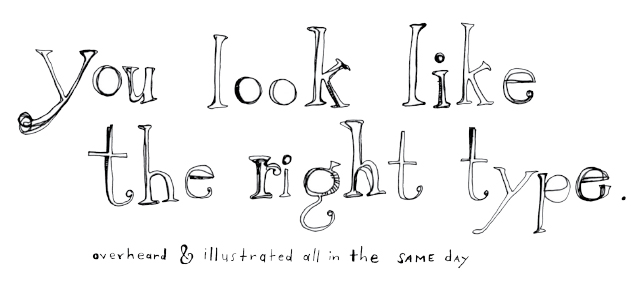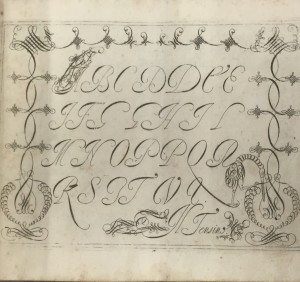
Seven years ago Mark Addison Smith was standing around in Chicago’s Loop when a woman approached and asked him for a cigarette. Mark does not smoke and when the woman departed with the words “ahh you look like the right type,” the phrase stuck with him. He went home and illustrated the woman’s words. He now lives in New York and continues to illustrate the words of the people he encounters in his daily life.
Mark maintains WordPress, Facebook, and Instagram accounts to showcase the works he produces. When a phrase catches his ear he illustrates it same day, and he does this every day. The actual words spoken are displayed in various fonts and and are placed around an simple illustration in black ink. The lines of the illustration often connect with the word themselves with common themes of light switches, human forms, and books. Sometimes the font chosen for the overheard dialogue is the illustration itself.
Mark’s work relates to WRD 205 in several areas. First is the obvious word play of the word “type” being used by the woman to described Mark’s assumed personal characteristics and the definition associated with typefaces as part of a writing system. In Boardley’s article on the history of alphabets we learned how many of the current alphabets evolved from from cuneiform into Phoenician type where it was altered by the various populations. Later in the history of the Roman alphabet the gothic script appeared without reason in the 12th century. Researches have unsuccessfully searched for clues on the script’s origins and popularity. Throughout the history of alphabets and writing systems people have been manipulating the types and adding illustrated flourishes to compliment the message of the message of the text. We have illuminated manuscripts and the detailed imagery of Arabic calligraphy. Mark continues this tradition daily in his work. We have discussed how pictures convey ideas and writing conveys language. Mark uses words and pictures to document and celebrate the spoken language of those passing encounters.
I personally find Mark’s work in this series to be enlightening, humorous, and well executed. We read the phrases without the context of only the included illustration and see statements on current life from stranger in the midst of a casual conversation. As much as I love the series the addition of line drawings to script is nothing new. On our trip the DePaul library we got to handle a little book titled “Le merauiglie della penna conchiudenti in diuersi modi di scriuere delieneati, et intaglia da A. Tensino Codognese.” In this collection of writing styles from 1640 A.D. there were treasures like this:
I invite you pay close attention to the figure sitting on the leg of the letter Q. Each of the pages included simple figure drawings of angels, soldiers, and animals. Tensio chose to add the artistic flourishes when no know function for them could exist.
In the latest reading we explored the history of the pencil and the computer as writing systems. One impact of a computer based writing system is that we have less control over personal touches to our written script. In some cases like my illegible cursive this is a good thing, but I have a bit of worry for the future Mark’s of the world. However, I do not see handwriting classes disappearing from elementary education any time soon. I remember fondly learning the cursive letter form Mrs. Potts at Rains Elementary School. I was particularly excited to get to the cursive “Q” with its elegance and resemblance to the number 2. As I entered junior high I constantly tried to change my handwriting and perfected a minuscule printed script by my sophomore year. I still prefer to write letter in cursive though I often sacrifice quality for speed. My notes for class are legible to only me as I’ve developed a personal shorthand for note taking.
I consider myself lucky to have met Mark several times through a mutual friend. His engaging and friendly personality have made me a bit biased towards his work. He is awesome therefore his work is awesome, however, as we explore shifting writing systems I invite you explore his work and his particular stylistic writing systems he uses to show his world to us.
Mark’s wordpress can be found here, and he can found on Instagram @markaddisonsmith . You can also view work from his series Years Yet Yesterday, a Larry Kramer Abecedary at The Center on Halstead. I will be writing about Mark’s work Larry Kramer’s speech “The Tragedy of Today’s Gays” in 2004 in a later post.



